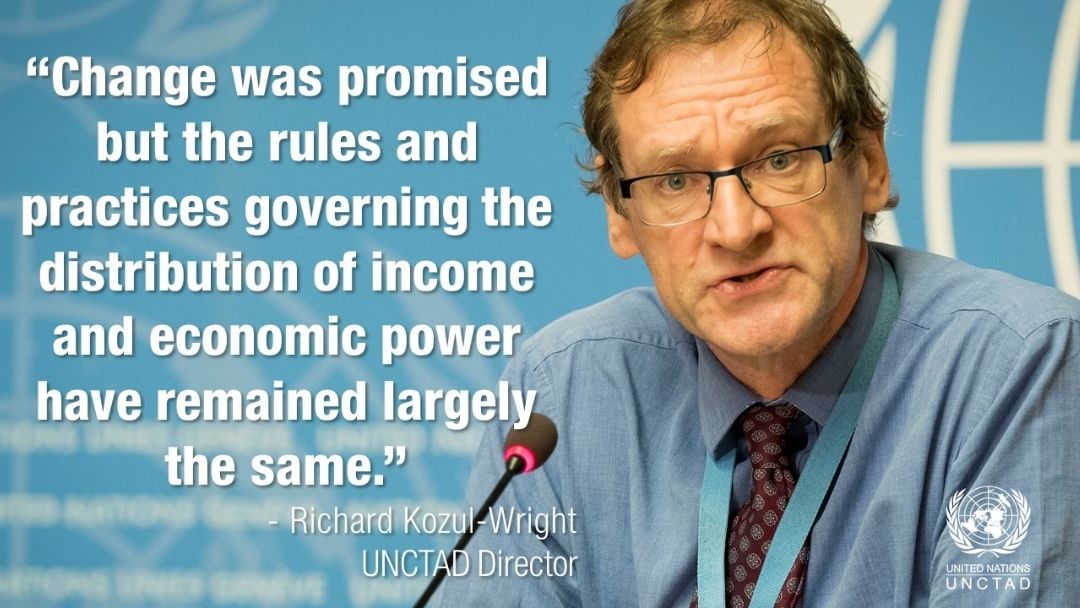
India’s economy is forecast to contract by 5.9 per cent in 2020, due to the impact of COVID-19 pandemic recent report by the UN says.
On September 22, the United Nations Conference on Trade And Development (UNCTAD) had published the ‘Trade and Development Report 2020’ showing the impact of COVID-19 pandemic on the global economy. It had stated that the world economy will diminish by 4.3 per cent in 2020 and is currently undergoing a ‘deep recession’. This will translate into a loss of 6 trillion dollars (Rs 4,41,39,300 crore).
Moreover, India’s Gross Domestic Product (GDP) is stated to shrink by 5.9 per cent in the financial year 2020-’21 and recover to 3.9 per cent 2021-’22.

Highlights of ‘Trade and Development Report 2020’: Global Scenario
- The world is struggling with the possibility of a complete wipeout of the Brazilian, Indian and Mexican economies;
- Trade will reduce by 20 per cent or one-fifth this year, the Foreign Direct Investment (FDI) will shrink by up to 40 per cent, with Remittances dropping by over USD 100 billion;
🔴Trade will shrink by 1/5 this year
🔴 FDI will shrink by up to 40%
🔴 Remittances will drop by over $100 billionBut the greatest damage will be in the developing world, where 90-120 million people will be pushed into extreme poverty. #TradeDevReport ➡ https://t.co/1ViULCXKsF pic.twitter.com/m7ep4ssLRI
— UNCTAD, the UN trade & development body (@UNCTAD) September 24, 2020
- South Asia economy is expected to contract by 4.8 per cent in 2020-’21 but then recover to 3.9 per cent in 2021-’22;
- The first half of 2020 witnessed a sharp drop in its output, as the biggest absolute fall would be seen in the developed countries. Some countries are even set to face a ‘double-digit’ decline over the year. The report shows the current ‘generalised global recession’, will match the ‘Great Depression’ of the 1929-33;
For the first two quarters of this year, data from the @UNCTAD shows that the #pandemic saw #Economic output contract more sharply than in 2008-2009. https://t.co/cfMGweGswD #UnitedNations #COVID19 #Africa
— The Exchange Africa (@TheExchangeEA) September 25, 2020
- By 2021 the economies are expected to bounce back on the right track. However, this will be uneven across the countries;
- Unemployment will be on the rise with a large number of companies facing the problem of ‘bankruptcy’;
- Uncertainty will continue to exist with the economy’s demand and supply being weak, with a lack of confidence in the market;
- The debt levels of the public and private sectors could increase massively than the pre-COVID recorded levels;
- The greatest economic and social damage will be in the developing world, where levels of informality are high, commodities and tourism a significant sources of foreign exchange, and fiscal space has been squeezed under a mountain of debt;
- Around 90 million to 120 million people of the developing world will be dragged into poverty, along with approximately 300 million people facing food insecurity;
- Even if the economy’s activities bounce back and the developed nations were to follow the necessary fiscal and monetary measures, employment will not entirely recover. Several countries will remain in debt distress, and the income gaps will enlarge even more.
- China will grow at 1.3 per cent in 2020-’21, and a whopping 8.1 per cent the following year.
Indian Scenario:
In case of India, the baseline scenario is a sharp recession in 2020 following strict lockdown measures to stem the virus’ spread brought many productive activities to a halt across the country, according to the UN report. Indian economy’s contraction by 5.9 per cent in the current fiscal year could lead to permanent income loss.
Richard Kozul-Wright, Director at UNCTAD’s Division on Globalization and Development Strategies, mentioned that a ‘V-shaped recovery’ is misleading and the same will require a ‘double-digit’ growth in 2021, which is not possible!
“Forecasters’ talk of a V-shaped recovery can easily mislead. Such a recovery would require double-digit global growth next year, which is out of the question."
— Richard Kozul-Wright, UNCTAD director.🆕2020 #TradeDevReport ➡ https://t.co/bdEoSKPikd pic.twitter.com/D6g9fmgFbm
— UNCTAD, the UN trade & development body (@UNCTAD) September 24, 2020
#Coronavirus: What is a K-shaped economic recovery?@UNCTAD's Richard Kozul-Wright has been explaining to @bbcaaron how we can avoid the rich getting richer and the poor getting poorer.#TradeDevReport #covid #economics https://t.co/4zk3o4YRH9 pic.twitter.com/2fpjEpEVtf
— Jonathan Josephs (@jonathanjosephs) September 24, 2020
Mukhisa Kituyi, UNCTAD’s Secretary-General, said that building a better nation requires smart actions. He further added that, “The lives of future generations, indeed of the planet itself, will depend on the choices we all take over the coming months.”
Other projections:
On September 8, American credit rating agency Fitch Ratings projected a contraction of 10.5 per cent instead of its earlier estimate of a 5 per cent contraction for India’s economy in the current fiscal year. Last month, official data published showed that the country’s GDP shrank 23.9 per cent in the April-June period, triggered by the stringent lockdown, making the contraction one of the sharpest contractions in the world.
The agency, however, forecast that India’s economy will grow by 11 per cent in the financial year 2021-’22 and 6 per cent in 2022-’23.
Meanwhile, the Asian Development Bank on September 15 predicted that the Indian economy would contract by 9 per cent this financial year.
Domestic rating agency India Ratings and Research, revised India’s GDP growth forecast for the financial year 2020-’21 to -11.8 per cent from -5.3 per cent. The agency added that it expects India’s GDP to rebound and grow at 9.9 per cent year-on-year in the financial year 2021-’22 due to a weak base in 2020-’21.





